How to Use Yoga to Strengthen Your Pet's Muscles
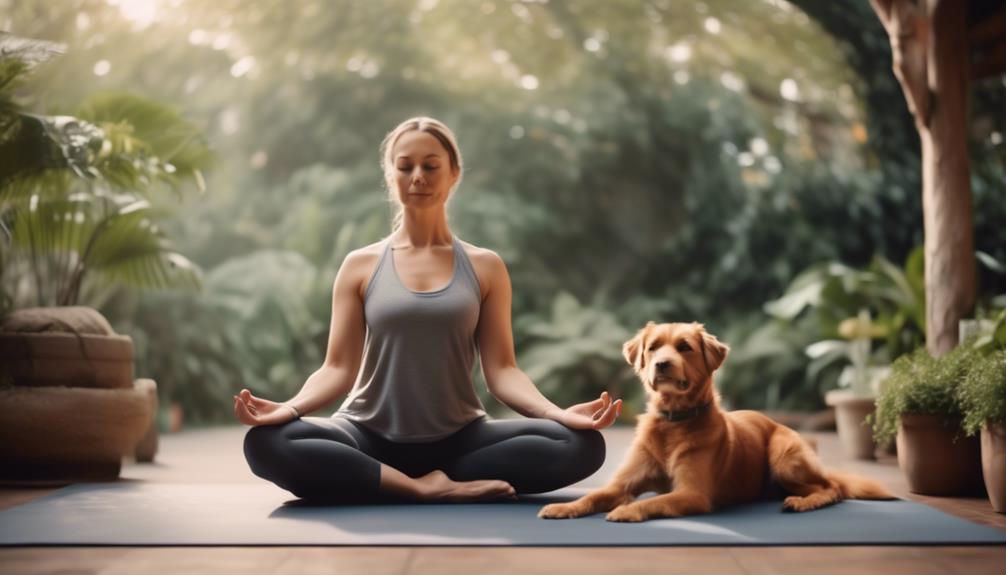
Yoga can effectively strengthen your pet's muscles and improve their mobility. This holistic approach to their fitness routine offers a range of benefits.
By incorporating yoga into your pet's exercise regimen, you can help them build strength and flexibility. This is particularly important for pets who may have physical limitations or are recovering from an injury.
Regular yoga practice can also enhance your pet's balance and coordination. It can improve their posture and alignment, reducing the risk of musculoskeletal issues in the long run.
Additionally, yoga can provide mental stimulation and relaxation for your pet. The focused breathing and mindful movements can help reduce anxiety and promote a sense of calmness.
Overall, integrating yoga into your pet's routine can contribute to their overall well-being and quality of life. It's important to consult with a professional who specializes in pet yoga to ensure that the practice is safe and appropriate for your pet's individual needs.
Key Takeaways
- Yoga can benefit pets by improving their flexibility, muscle strength, balance, and coordination.
- It provides mental stimulation and relaxation, contributing to their overall well-being and quality of life.
- Before engaging in pet yoga, it is important to use the right equipment, warm up the pet properly, and listen to their cues.
- Different yoga poses can target specific muscle groups and help strengthen them, such as Downward-Facing Dog, Upward-Facing Dog, Warrior II, Bridge Pose, and Tree Pose.
Benefits of Yoga for Pets
Yoga offers numerous benefits for pets, including improved flexibility, increased muscle strength, and enhanced mental well-being. Pet yoga classes, led by trained pet yoga instructors, can provide a safe and structured environment for pets to engage in these beneficial activities.
One of the main benefits of pet yoga is improved flexibility. Just like humans, pets can experience tight muscles and limited range of motion. Practicing yoga poses can help to stretch and lengthen their muscles, improving their overall flexibility and mobility. This can be particularly beneficial for older pets or those recovering from injuries.
In addition to flexibility, pet yoga also helps to increase muscle strength. Many yoga poses require pets to engage and hold specific positions, which can help to strengthen their muscles over time. Strong muscles not only support their physical health but also contribute to better balance and coordination.
Furthermore, pet yoga has a positive impact on their mental well-being. The practice of yoga promotes relaxation and reduces stress, helping pets to find a sense of calm and balance. This can be especially beneficial for pets who may experience anxiety or hyperactivity.
Preparing Your Pet for Yoga
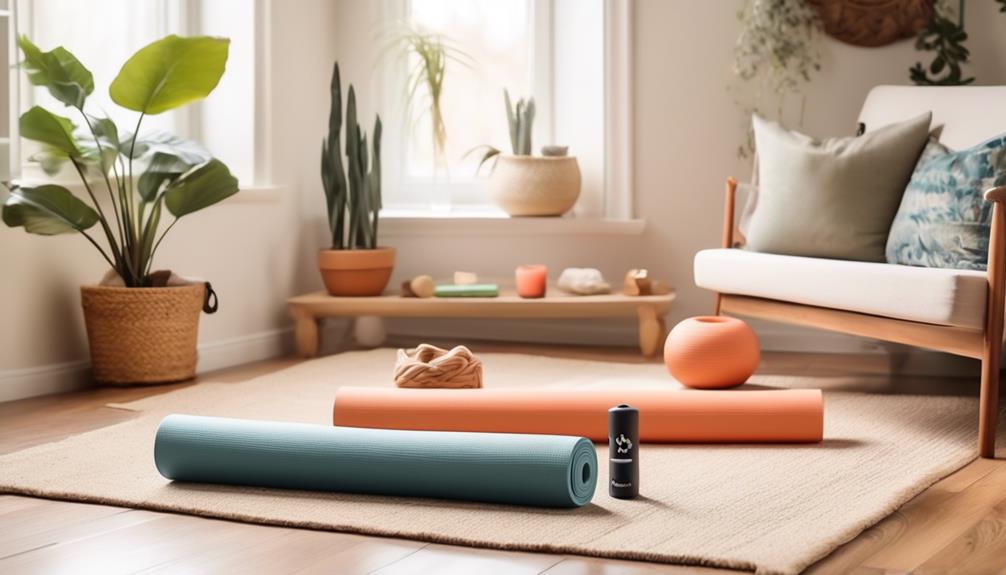
After understanding the benefits of pet yoga, it's important to know how to prepare your furry friend for their yoga practice. Preparing your pet for yoga involves several key steps to ensure a safe and effective practice.
First and foremost, it's essential to have the right pet yoga equipment. This includes a non-slip yoga mat specifically designed for pets, as well as any necessary props such as blocks or straps. These items will provide stability and support during the practice, helping to prevent any injuries.
Additionally, it's crucial to avoid common mistakes in pet yoga. One common mistake is pushing your pet too hard or forcing them into poses they aren't comfortable with. It's important to remember that each pet is different and may have different limitations or abilities. It's essential to listen to your pet's cues and only push them as far as they're comfortable.
Another mistake isn't properly warming up your pet before starting the yoga practice. Just like humans, pets need to warm up their muscles before engaging in physical activity. Taking your pet for a short walk or engaging in some gentle stretching exercises can help prepare their muscles for the yoga practice.
Essential Yoga Poses for Pet Strength
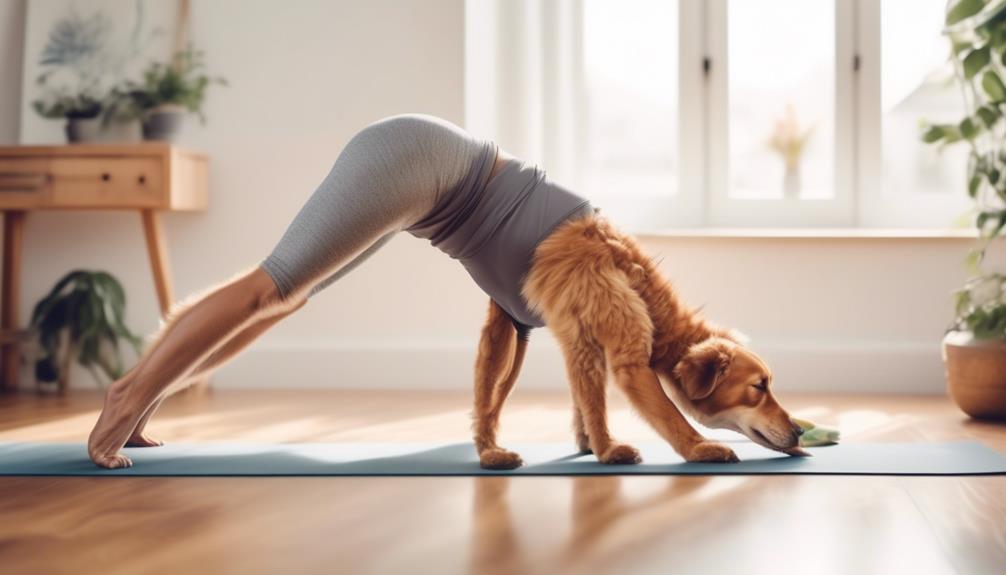
To help strengthen your pet's muscles through yoga, incorporating essential poses into their practice is key. These yoga poses not only improve flexibility but also provide mental health benefits for your furry friends.
Here are five essential yoga poses that can strengthen your pet's muscles:
- Downward-Facing Dog: This pose stretches and strengthens the entire body, including the legs, core, and back muscles. It also helps to relieve stress and anxiety in pets.
- Upward-Facing Dog: This pose opens up the chest and strengthens the back, shoulders, and abdominal muscles. It improves posture and enhances overall body strength.
- Warrior II: This pose targets the leg muscles, including the quadriceps and hamstrings, while also engaging the core and arms. It improves balance and stability in pets.
- Bridge Pose: This pose strengthens the back, glutes, and leg muscles. It also helps to improve flexibility in the spine and relieve tension in the hips.
- Tree Pose: This pose engages the core and leg muscles while promoting balance and concentration. It also helps to improve coordination and stability in pets.
Incorporating these essential yoga poses into your pet's practice won't only strengthen their muscles but also enhance their flexibility and mental well-being.
Modifying Poses for Different Pet Sizes
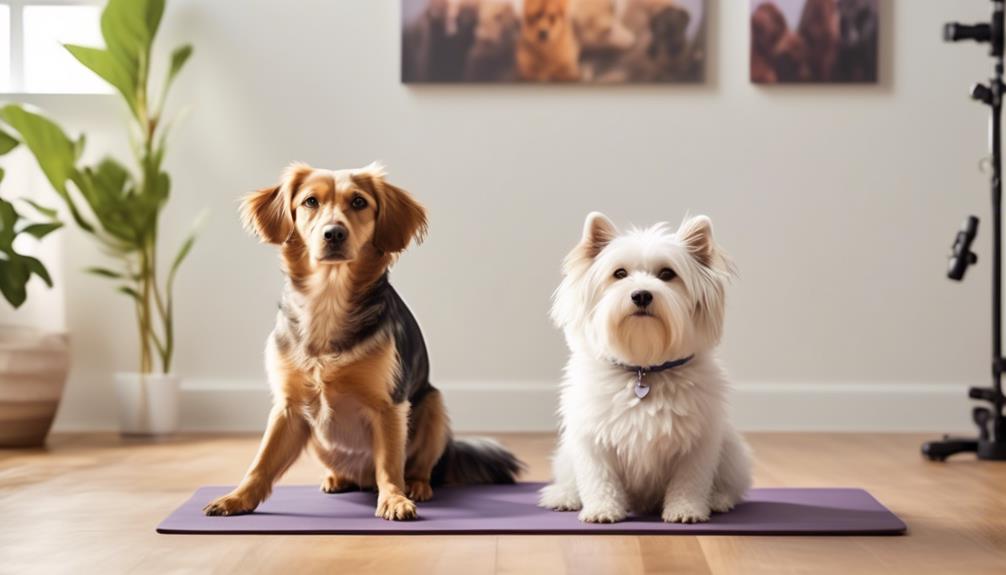
When modifying yoga poses for different pet sizes, it's important to consider their unique physical characteristics and limitations. This is especially true when it comes to senior pets or those with injuries.
Modifying poses for senior pets involves taking into account their decreased flexibility and joint mobility. For example, you may need to lower the height of certain poses or provide additional support to help them maintain balance. It's also important to focus on gentle stretching and movements to avoid putting strain on their muscles and joints.
For injured pets, yoga can be a beneficial form of rehabilitation. Modifying poses for injured pets involves providing extra support and ensuring that the poses are gentle and low impact. For example, you may need to use props such as blankets or bolsters to provide additional support and cushioning. Additionally, you may need to avoid poses that put excessive strain on the injured area and instead focus on poses that promote healing and flexibility.
Incorporating Props and Toys for Added Challenge
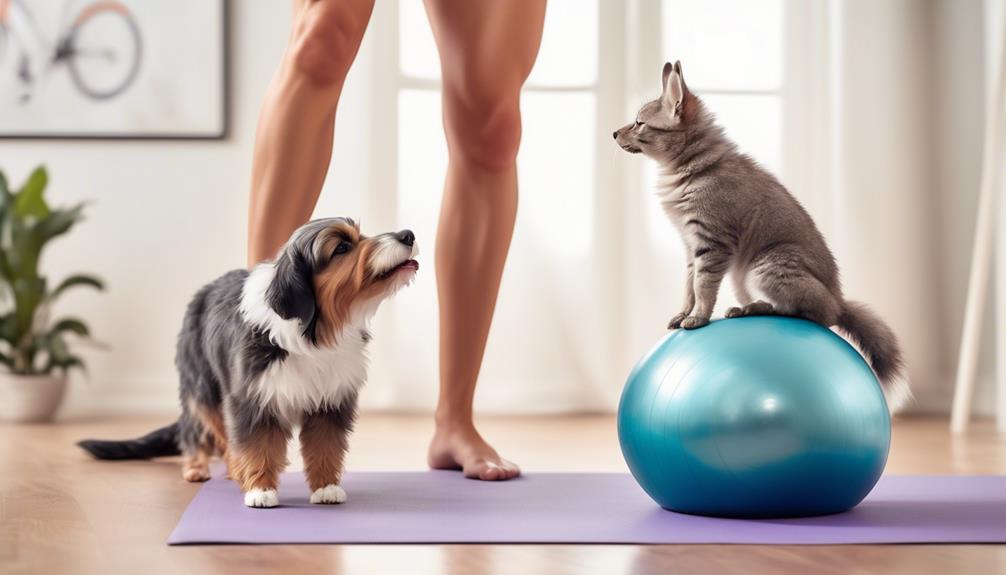
Incorporating props and toys can provide an added challenge to your pet's yoga practice, enhancing their strength and flexibility. By using these tools, you can modify poses and introduce new elements to make your furry friend's workout more engaging and effective.
Here are five ways to incorporate props and toys into your pet's yoga routine:
- Balance discs: Placing a balance disc under your pet's paws during poses like downward dog or plank can help improve their core strength and stability.
- Tug-of-war ropes: Using a tug-of-war rope during poses like warrior or lunges can add resistance and challenge your pet's muscles even further.
- Tennis balls: Placing a tennis ball between your pet's paws during poses like bridge or wheel can help activate their leg muscles and improve their balance.
- Treat puzzles: Incorporate treat puzzles into poses like seated forward fold or spinal twist to engage your pet's mind and body simultaneously.
- Hula hoops: Using a hula hoop as a prop during poses like standing stretches or circles can help your pet improve their coordination and flexibility.
Remember to always supervise your pet while using props and toys and ensure they're safe and appropriate for their size and abilities.
With these creative additions, your pet's yoga practice will become more enjoyable and beneficial, helping them build strength and flexibility in a fun and engaging way.
Safety Tips for Practicing Yoga With Your Pet
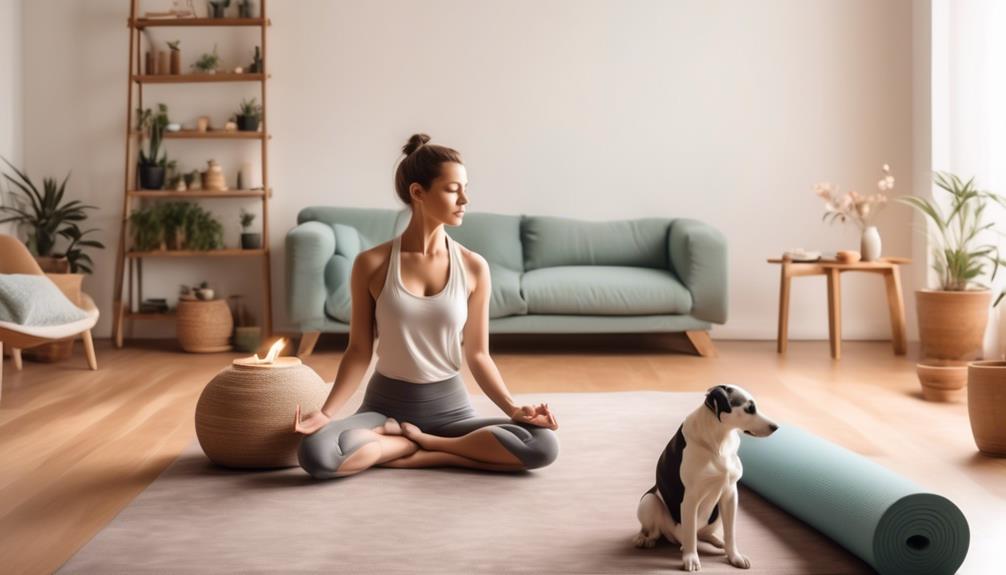
When practicing yoga with your pet, it's important to focus on pet-friendly poses that are safe and comfortable for them. Proper alignment techniques should be used to ensure that your pet's muscles and joints are protected during the practice.
It's also crucial to start with gradual progression exercises to prevent injury and allow your pet to build strength and flexibility over time.
Pet-Friendly Yoga Poses
To ensure a safe and enjoyable yoga practice with your pet, it's important to follow these safety tips:
- Start with simple poses: Begin with basic poses that are easy for your pet to follow, such as downward-facing dog or cat-cow stretch.
- Use pet-friendly yoga accessories: Invest in pet-friendly yoga mats or blankets to provide your furry friend with a comfortable surface to practice on.
- Be mindful of your pet's limitations: Pay attention to your pet's physical abilities and adjust the poses accordingly. Avoid any poses that may cause discomfort or strain.
- Keep sessions short and fun: Pets have shorter attention spans, so keep the yoga sessions brief and engaging. Incorporate treats or toys to make it a positive experience.
- Offer plenty of breaks and water: Pets can easily become fatigued during yoga, so make sure to offer regular breaks and access to fresh water.
Proper Alignment Techniques
One key aspect of practicing yoga with your pet is ensuring proper alignment techniques for their safety and well-being. Just like humans, pets can benefit from correct alignment during yoga poses to prevent injury and maximize the benefits of the practice.
When practicing yoga with your pet, it's important to make modifications based on their size and body type. For example, if you have a smaller pet, you may need to adjust the poses to accommodate their shorter limbs and smaller muscles. On the other hand, larger pets may require additional support or props to maintain proper alignment.
It's essential to observe your pet's comfort level and make adjustments accordingly. By incorporating alignment techniques and modifications for different sizes, you can ensure a safe and effective yoga practice for your pet.
Gradual Progression Exercises
Incorporating gradual progression exercises is essential for ensuring the safety and well-being of your pet while practicing yoga together. By using these progression techniques, you can gradually build your pet's muscles and increase their flexibility over time. Here are some important considerations to keep in mind:
- Start with simple poses: Begin with basic poses that are easy for your pet to understand and execute, such as the downward dog or the cat-cow pose.
- Gradually increase duration: Start with shorter sessions and gradually increase the time spent in each pose to prevent strain or fatigue.
- Modify poses as needed: Adjust the poses to accommodate your pet's unique anatomy and physical abilities. Use props like blankets or cushions to provide support if necessary.
- Monitor your pet's comfort level: Pay attention to any signs of discomfort or pain during the exercises. If your pet seems uneasy, modify the pose or consult with a veterinarian.
- Consult with a professional: Consider working with a certified yoga instructor who specializes in pet yoga to ensure proper guidance and support.
Creating a Regular Yoga Routine for Your Pet
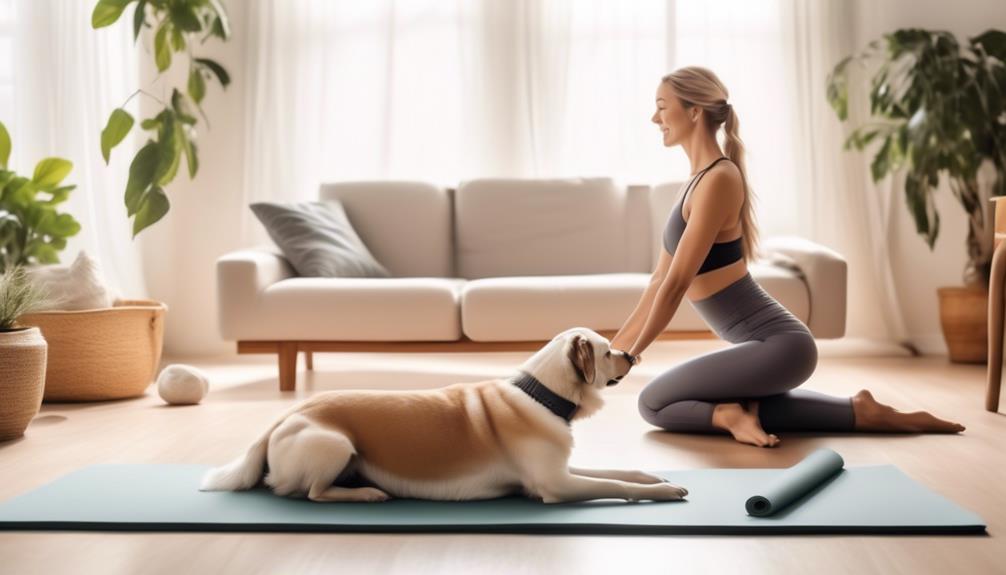
Creating a regular yoga routine for your pet is essential for their overall well-being.
Weekly yoga sessions can help strengthen their muscles and improve their flexibility.
When choosing poses for your pet, it's important to consider their size, age, and any existing health conditions to ensure a safe and effective practice.
Weekly Yoga Sessions
To establish a consistent yoga routine for your pet, consider incorporating weekly yoga sessions into their schedule. These sessions won't only help strengthen their muscles but also provide mental stimulation and relaxation.
Here are some key benefits of weekly yoga sessions for your pet:
- Physical conditioning: Regular yoga sessions will help improve your pet's flexibility, balance, and overall physical fitness.
- Bonding time: Participating in weekly yoga sessions with your pet is a great way to strengthen the bond between you and your furry friend.
- Stress relief: Yoga poses and breathing exercises can help reduce stress and anxiety in your pet, promoting a sense of calmness and relaxation.
- Socialization: Group yoga classes for pets offer an opportunity for your furry companion to socialize with other animals, promoting healthy interactions and social skills.
- Mental stimulation: The focus required during yoga sessions can help stimulate your pet's mind and improve their cognitive abilities.
Choosing Appropriate Poses
When establishing a regular yoga routine for your pet, it's important to choose appropriate poses that cater to their specific needs and abilities. Just like humans, pets have different body structures and limitations that need to be considered.
Start with simple poses that promote flexibility and strength, such as downward-facing dog or cat-cow stretch. As your pet becomes more comfortable, you can gradually introduce more challenging poses like warrior or bridge pose.
It's also essential to have appropriate props, such as yoga mats or blankets, to ensure their safety and comfort during the practice. Additionally, incorporating breathing techniques can help your pet relax and focus during the yoga session. Encourage slow and deep breaths, synchronizing them with the movements.
Remember to consult with a veterinarian before starting any yoga routine for your pet to ensure it's suitable for their specific needs.
Frequently Asked Questions
Can I Practice Yoga With My Pet if They Have a Pre-Existing Medical Condition or Injury?
If a pet has a pre-existing medical condition or injury, it is important to modify yoga practice accordingly. Certain poses may need to be avoided, and gentle stretching and strengthening exercises can be beneficial.
Is It Necessary to Have Prior Yoga Experience in Order to Practice Yoga With My Pet?
Is prior yoga experience necessary to practice with a pet? While it can be helpful, it's not essential. Yoga benefits for pets include improved flexibility and strength. Tips for introducing your pet to yoga include starting slow and using positive reinforcement.
Can I Practice Yoga With Multiple Pets at the Same Time?
Yes, it is possible to practice yoga with multiple pets at the same time. However, it may require extra attention to manage distractions during the session.
How Long Should Each Yoga Session Be for My Pet?
The length of a yoga session for a pet can vary depending on their size and fitness level. It is recommended to start with shorter sessions, around 10-15 minutes, and gradually increase the duration as their muscles strengthen.
Are There Any Specific Dietary Recommendations for Pets Who Are Practicing Yoga?
There are no specific dietary recommendations for pets practicing yoga. However, it is important to ensure that your pet's diet is balanced and provides all the necessary nutrients to support their overall health and muscle strength. Incorporating yoga into your pet's exercise routine can have numerous benefits, including improved flexibility, increased muscle tone, and reduced stress levels.









